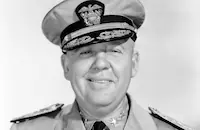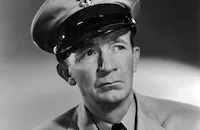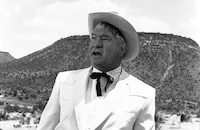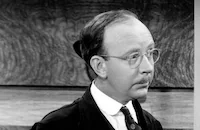Stand by for Action

Brief Synopsis
Cast & Crew
Robert Z. Leonard
Robert Taylor
Charles Laughton
Brian Donlevy
Walter Brennan
Marilyn Maxwell
Film Details
Technical Specs

Synopsis
At a West Coast Naval base, just after America's entry into World War II, Harvard-educated Lieut. Gregg Masterman, aide to Rear Admiral Stephan "Iron Pants" Thomas, incurs the ire of up-from-the ranks officer Lieut. Comdr. Martin J. Roberts because Roberts thinks Masterman is delaying his ship's return to sea. When Roberts goes to Thomas to complain, Thomas recognizes Roberts from their World War I service and assigns him to be skipper of the "mothball" destroyer the U.S.S. Warren . That night, Masterman is chagrined to learn that Thomas has made him Roberts' executive officer. Masterman goes to see Roberts on the Warren and encounters former chief yeoman Henry Johnson, who had served on the ship during World War I, and has been her civilian caretaker. Johnson enthuses both officers about the decaying Warren when he tells them the ship's proud history, but they remain cool to each other, especially after Roberts tells Johnson he cannot serve again because the war will be "too tough for grey hairs." Roberts warns Masterman that sentiment has no place when making life and death decisions, but on his way out, Masterman suggests to Johnson that without grey hair, he would look much younger. On the first day at sea, a now dark-haired Johnson is in the ranks, having obtained Masterman's help in getting back into the Navy. Despite their differences, as the voyage gets underway, Roberts and Masterman gain respect for each other. Meanwhile, Thomas is reassigned to head a Navy convoy and summons the Warren to replace one of his damaged vessels. On the way, the Warren is attacked by a Japanese plane, which then manages to get away, in part because of a mistake Masterman and his men make. Masterman blames himself, but Roberts tells him not to be too hard on himself. A short time later, a violent storm arises, during which Johnson is knocked unconscious. When pharmacist's mate "Doc" Miller says that the pounding sea might hinder Johnson's recovery, Masterman reduces the ship's speed, against the captain's orders. Roberts reverses Masterman's decision and warns him that command means making unpopular decisions. Nearing Thomas' convey, the Warren encounters a lifeboat occupied by two women and twenty infants, survivors of a torpedoed rescue ship. One of the women is about to give birth and, as there is no doctor on board, carpenter's mate "Chips," whose wife is a nurse, helps with the delivery. As the ship reaches the convoy, sailors in the Warren 's "baby division" take their charges on deck for some sun. Looking through binoculars, from their ship, the Chattanooga , Thomas and his officers see a naked baby crawling on deck of the Warren and mistake it for a pig. Soon set straight by communiques from Roberts, Thomas congratulates them on their successful "launch" of the new baby. Now the other female on board, Mrs. Collins, goes into labor, but is having a very difficult time. Masterman wants to transfer her to the Chattanooga , because there is a doctor on board, but Roberts refuses because both ships would have to stop. Thomas, who is also worried about the newest "launch," recalls a British naval tradition from the days when women accompanied their husbands to sea, whereby difficult births were helped along by cannon fire. Just then, Japanese planes from an approaching carrier bomb the Chattanooga , destroying its rudder and making it go in circles in the fog. As the Warren joins the battle, Roberts is hit and temporarily relinquishes command to Masterman. Now that Masterman is in charge, he, too, realizes that decisions must be based on the need of the ship, not sentiment. During a fierce battle, Johnson, who has recovered, rises from his bed and helps the Warren destroy the Japanese battleship, and Mrs. Collins gives birth to a healthy baby boy. Some time later, when the convoy arrives in San Francisco, the Chattanooga is towed by the Warren , after which Roberts, Masterman and Johnson are each awarded the Navy Cross. When the Warren returns to sea, Roberts and Masterman contentedly stroll the deck together.

Director

Robert Z. Leonard
Cast

Robert Taylor

Charles Laughton

Brian Donlevy

Walter Brennan

Marilyn Maxwell

Henry O'neill
Marta Linden

Chill Wills

Douglass Dumbrille

Richard Quine
William Tannen

Douglas Fowley
Tim Ryan
Dick Simmons

Byron Foulger

Hobart Cavanaugh
Inez Cooper
Ben Welden
Harry Fleischmann
Theodor Von Eltz
Robert Kent
Bea Nigro
William Roberts
Douglas Wood

Elizabeth Russell
Oscar "dutch" Hendrian
Spec O'donnell
Harry Wilson
Billy Bletcher
Pat West
Frank Hagney
Duke York
Will Armstrong
Ernie Alexander
Ralph Mccullough
Hal Le Sueur
Calvin Emery

James Davis

Wally Cassell

James Millican
Frank Whitbeck
Crew
John L. Balderston
George Boemler
Edward G. Boyle
George Bruce
Orville O. Dull
Cedric Gibbons
Arnold Gillespie
Red Golden
Captain Harvey Haislip U.s.n.
Lennie Hayton
Horace Hough
Don Jahraus
Laurence Kirk
Robert Z. Leonard
Herman J. Mankiewicz
Urie Mccleary
Charles Rosher
Sandy Roth
Douglas Shearer
R. C. Sherriff
Lieut. Comdr. H. D. Smith U.s.n.
Michael Steinore
Edwin B. Willis

Photo Collections
Film Details
Technical Specs

Award Nominations
Best Special Effects
Articles
Stand By For Action
The film's release was timely, following closely as it did on the heels of some important U.S. successes against the enemy in the Pacific. Aware that much of the wartime stateside audience was made up of women, the studio threw in a little something they assumed would give it female appeal. In the middle of all the rugged naval action, the ship picks up a lifeboat filled with babies and their two nurses, survivors of a torpedoed ship. The picture strives for humor in having the male crew suddenly subbing as "moms."
Making her screen debut as one of the nurses was singer Marilyn Maxwell, who became a leading lady in a number of films of the 1940s and '50s but is perhaps best known for performing for many years with Bob Hope's USO tours. A curvy blonde with a sparkling personality, Maxwell first sang the song "Silver Bells" with Hope in the comedy The Lemon Drop Kid (1951), thereby introducing a new Christmas carol into the standard repertoire.
British transplant Charles Laughton did his part for the war effort by delivering a rousing shipboard speech emphasizing the crew's responsibility to the Navy, at the end of which he recited the entire Declaration of Independence. Director Robert Z. Leonard suggested cue cards to help the actor, but Laughton delivered it from memory without a single mistake. When he was finished the entire cast and crew burst into applause. Despite this notable feat, Laughton did not feel good about this picture, claiming his performance was something out of HMS Pinafore, a sentiment shared by the New York Times's Bosley Crowther. Many of Laughton's most acclaimed performances - among them The Hunchback of Notre Dame (1939), Mutiny on the Bounty (1935) and his Oscar®-winning The Private Life of Henry VIII (1933) - were behind him. He had hit something of a slump in the quality and importance of his roles and neither this nor his next few pictures brought him out of the resulting depression. Things would pick up again at the end of the decade, beginning with his domineering tycoon in The Big Clock (1948).
Despite some lukewarm reviews, Stand by for Action did well at the box office and the Special Effects team garnered an Academy Award nomination.
Director: Robert Z. Leonard
Producers: Orville O. Dull, Robert Z. Leonard
Screenplay: George Bruce and John L. Balderston, Herman J. Mankiewicz, based on stories by Harvey S. Haislip and R.C. Sherriff, and Laurence Kirk
Cinematography: Charles Rosher
Editing: George Boemler
Art Direction: Cedric Gibbons
Original Music: Lennie Hayton
Cast: Robert Taylor (Lt. Gregg Masterman), Charles Laughton (Rear Admiral Stephen Thomas), Brian Donlevy (Lt. Cmdr. Martin J. Roberts), Walter Brennan (Chief Yeoman Henry Johnson), Marilyn Maxwell (Audrey Carr).
BW-110m. Closed captioning.
by Rob Nixon

Stand By For Action
Quotes
Trivia
Notes
Working titles of the film were Cargo of Innocence, A Cargo of Innocents, Men O'War, Clear for Action, Navy Convoy, This Man's Navy and Pacific Task Force. According to M-G-M production records, the film was released in a December 1942-February 1943 package, although the picture appears to have been shown only at "premiere" venues prior to January 1943. A brief opening montage is narrated by M-G-M advertising and exploitation executive Frank Whitbeck, who provided the "voice" for many M-G-M's trailers. Hollywood Reporter news items reveal the following information about the production: In November 1941, the film, which was initially known as Cargo of Innocence, was set for production at M-G-M's facilities in England, to star Robert Donat and Edmund Gwenn and to be directed by Clarence Brown. By early December 1941, "uncertain production possibilities" due to the war in Europe resulted in the studio's decision to move the film to Hollywood, with some backgrounds and "extraneous cover-up shots" to be made in England. At that time, the film was to have an Atlantic Ocean setting and deal with the British Navy. By March 1942, following American entry into the war, the production was planned as a total Hollywood shoot, and the setting was changed to the Pacific Ocean, featuring the American Navy.
Additional news items note that Stand By for Action, which was M-G-M's first naval picture of World War II, was filmed in cooperation with the U.S. Navy. Barry Nelson, who was not in the released film, was to have appeared in the production. Although a multi-city "world premiere" took place on New Year's Eve, 1941, news items variously reported that early December 1941 screenings had taken place for naval officers on Treasure and Mare Islands, CA and a December 23, 1941 premiere was scheduled for either Toledo or Cleveland, OH. The film did not receive good reviews either from the civilian or military press. Sgt. Bill Davidson, who reviewed films for Yank magazine, said that it was "not about The War, but about Hollywood's War." Other critics compared it unfavorably with the British naval drama In Which We Serve, which had opened in the United States a short time prior to the release of Stand By for Action. A. Arnold Gillespie, Dan Jahraus and Michael Steinore received an Academy Award nomination for special effects for the film.















